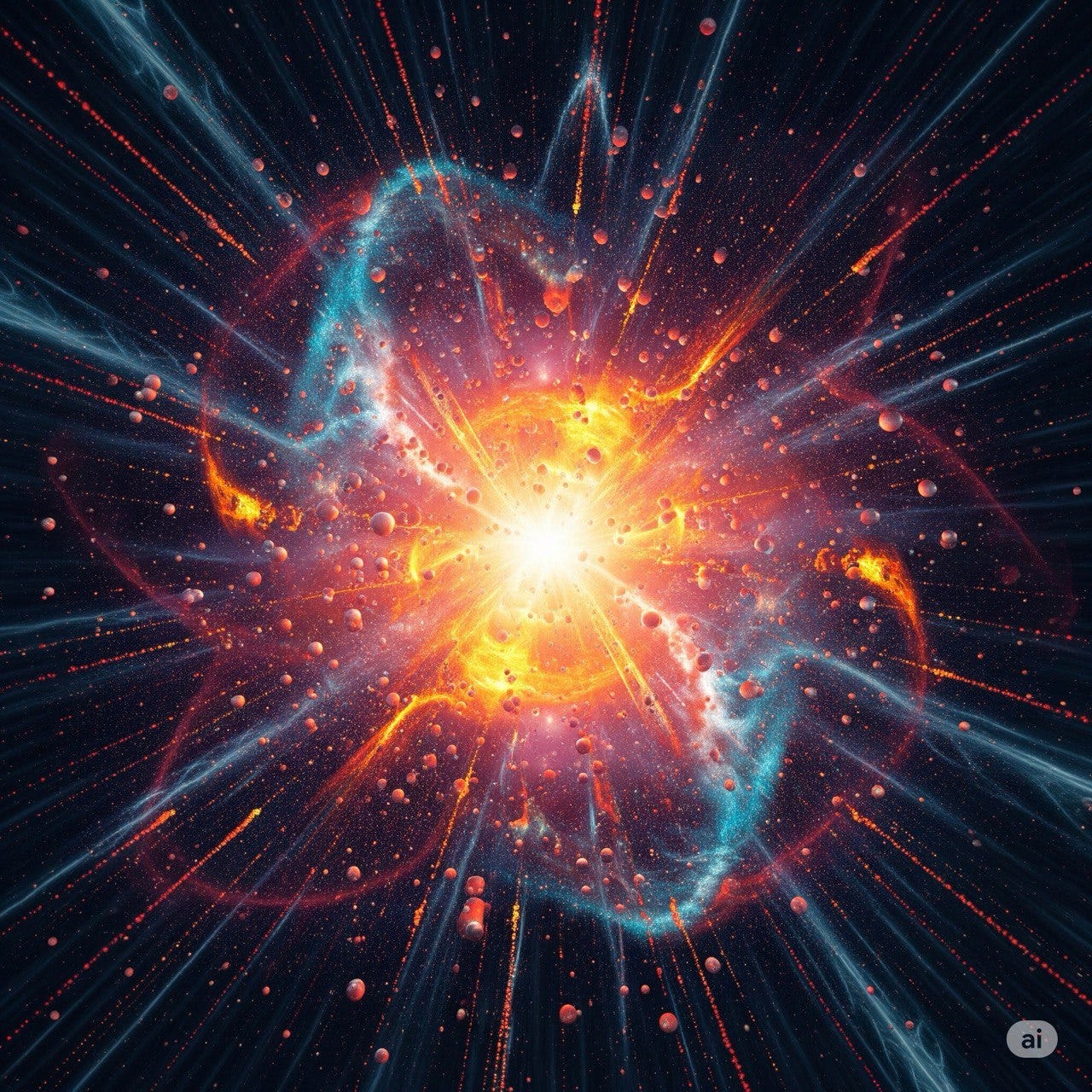Preface: This is the first of an ongoing series of essays, which draw on a cornerstone paper that proposes some ‘signposts’ of a theory of ‘Systemic Exchange Value’ (SEV) - a geopolitical economy of thermodynamics, information and exchange. This essay aims to introduce the concepts in a short and accessible way. The full ‘scholarly’ piece is available separately for those with a theoretical bent.
We are living in a world of overlapping economic, ecological and informational problems - perhaps even crises. In parts of the world, we sit on the precipice of economic stagflation, and, if not that, then recession. We are confronted by the realities of ecological constraints. And, cutting through all of this is what appears to be an ever-growing digital disorientation. Yet our dominant economic models remain almost silent on the one variable that underlies all of them: energy.
A way of thinking through this is through the foundational notion that value is energy. Every good or service we use or consume is the result of transforming energy from one form into another. For the sake of brevity, I call these goods and services ‘commodities’. Every transaction, every price, every unit of money is ultimately a placeholder for energy that has been, or will be, mobilised. If we want to understand where value comes from, and where our economies are heading, we must return to this thermodynamic foundation.
This idea is not new. In the 20th century, ecological economists like Nicholas Georgescu-Roegen and systems theorists like Howard Odum argued that energy - not money - is the real engine of economic life. But in a world shaped by ecological or material constraints, digital infrastructure and information overload, we now have the tools to go further. We can build a comprehensive, interdisciplinary framework that connects energy, information and money into a coherent model of how value is produced, distributed and adapted.
From Embedded Energy to Exchange Value
Every commodity is a container of embedded energy. That is, it takes energy to extract raw materials, refine them, transport them, assemble them, store them and deliver them. But critically, it also takes informational energy: the energy used to plan, organise, coordinate, store and communicate everything needed to make production possible. Information is part and parcel of the embedded energy of a commodity. Information is not only embedded energy itself, but is the critical bulwark against systemic entropy.
Embedded energy includes both the physical energy used in transformation and the informational energy required to reduce uncertainty and make the process coherent. This informational work - logistics, scheduling, design and quality control - is often invisible, yet energetically significant.
This embedded energy gives a product its use value, that is, its capacity to deliver utility or enable further production. But what determines its exchange value, the price it fetches in the market?
The answer lies in a concept called EROEI: Energy Return on Energy Invested. The exchange value of a commodity is a function of the intersection between the EROEI in the commodity as a result of its production process (what we can denote as EROEIp) as well as the EROEI potential for future use (EROEIu). Exchange value, then, is not arbitrary or a matter of supply and demand. It is conditioned by the efficiency with which energy - both physical and informational - is transformed and used.
Abundance Isn’t Volume - It’s Available Energy in Potential
This leads to a redefinition of abundance. Abundance isn’t the amount of stuff we have. It is the amount of Available Energy in Potential (AEP); that is, the usable energy we can still mobilise for productive purposes before it is lost to entropy.
In thermodynamics, entropy is the tendency of energy to dissipate into less useful forms. Every act of production or consumption increases entropy, whether in the form of waste, heat, disorder or uncertainty. The socio-economic system is always fighting this drift, not toward equilibrium, as mainstream economists imagine, but toward a moving frontier of adaptability.
The vitality of an economy depends on how much AEP it has at any given moment, and how well it can allocate that potential energy to productive, entropy-resisting systems. In this view, wages and profits are not just financial flows. They are claims on current or future energy surplus. And if that surplus dries up, or is wasted on energy inefficient pathways, the entire system begins to stagnate or collapse.
Information Is Energy and Must Be Counted As Such
We often treat information as immaterial, imagined as a cloud above the real economy. But this is an illusion. Data requires energy to collect, validate, process, transmit and store. Every app we use, every AI model, and every blockchain transaction consumes energy and emits heat. And just like physical commodities, information can be evaluated in terms of its EROEI.
Some data is high-value: a weather model that helps farmers reduce input waste, or a logistics algorithm that slashes fuel use across supply chains. Other data is low-value or even negative, adding clutter and increasing entropy without improving coordination. A sustainable digital economy requires that we evaluate information not by its volume, but by its entropy-reducing capacity; that is, by its ability to enhance systemic efficiency over time - economically and socially.
This brings us closer to Claude Shannon’s foundational insight: information is the inverse of entropy. In economic terms, good data is that which allows us to do more with less energy. It reduces uncertainty, enables synchronisation and improves feedback loops. Bad data does the opposite. It adds energetic cost without enabling better outcomes.
In this view, every embedded energy calculation must account for the information energy embedded within the commodity. This includes not only design and communication but also the software, databases, protocols and decision systems that make modern production and consumption possible. (I will outline a framework for dealing with the question of information viability in a separate essay.)
Money Is Not a Store of Value - It’s a Signal
In mainstream economics, money is often treated as a neutral medium, as a store of value or a facilitator of exchange. But in reality, I argue, money is better conceived as a forward-looking informational claim on energy. It is created endogenously, through credit, based on expectations of future production and repayment. Credit creation can take place via government expenditure or via commercial bank loans.
This means that every loan, every budget and every investment is a ‘bet’ on future EROEI. When money flows into high-EROEI sectors like renewables, public infrastructure or data systems that improve coordination, the economy expands its adaptive potential. When it flows into low-EROEI activities like speculative finance, inefficient real estate or extractive industries past their prime (with declining EROEI), it locks the system into fragile, energy-inefficient paths.
This is not just a technical problem. It is the structural cause of economic dysfunction and social anomie. When too much credit supports low-EROEI value circuits, we get maladaptation: declining productivity, rising entropy and systemic fragility. The economic system becomes rigid, unable to redirect energy and investment toward more viable futures. Think about financial crises occasioned by asset bubbles that the real economy simply cannot support.
Toward a Thermodynamic Economics
What does this mean for economics and for what are its implications for policy?
First, we need to stop thinking in terms of equilibria and static price signals. The economy is a non-equilibrium, thermodynamically open system, constantly shaped by the dialectic between entropy and adaptive effort. The goal is not balance as an end state, but dynamic resilience; that is, the ability to increase EROEI in use while managing entropy across energy, information and monetary circuits.
Second, we must evaluate all investments, whether they are public and private, based on their impact on system-wide EROEI, including the energy and entropy of information embedded in coordination systems.
Third, we must treat information infrastructure, especially digital payments, logistics and public data systems, as energy-saving assets. These systems reduce the energy cost of coordinating production and consumption. They accelerate the circulation of use values and reduce the need to hold energy or money in inefficient forms.
Finally, we must design monetary and financial systems to reward entropy-reducing behaviour. This may require central banks and financial institutions to assess not only creditworthiness but EROEI-worthiness, that is, whether a given investment increases the productive surplus (AEP) of the system.
A New Foundation
The economy is not a machine. It is not a market. It is not even a set of preferences. It is a circulating system of energy and information, embedded in a physical world governed by thermodynamic laws. If we continue to ignore these foundations, we will continue to build policies, institutions and systems that collapse under their own entropic weight.
But if we start from energy, from embedded energy as value, from entropy and adaptation, we may create a political economy that is not just efficient or productive, but alive to its own conditions of possibility.






